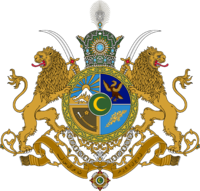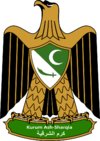Treaty between Çakaristan and Kurum Ash-Sharqia: Difference between revisions
(→Background: corr) |
(→State visit: corr) |
||
| Line 8: | Line 8: | ||
== State visit == | == State visit == | ||
[[File:Jaaguzan.jpg|100px|thumb|right|Shahanshah Jaaguzan]][[File:Salah Ad-Din.jpg|100px|thumb|right|center|Sultan Salah Ad-Din]] | [[File:Jaaguzan.jpg|100px|thumb|right|Shahanshah Jaaguzan]][[File:Salah Ad-Din.jpg|100px|thumb|right|center|Sultan Salah Ad-Din]] | ||
A formal state visit was organized from 11.XI.{{AN|1712}} tot 12.XI.1712 AN. A large delegation of 300 politicians, business men and people | A formal state visit was organized from 11.XI.{{AN|1712}} tot 12.XI.1712 AN. A large delegation of 300 politicians, business men and people from the cultural sector joined the Sultan and Grand Vizier [[Kawthar Saleh]] to [[Agra]]. In between the official ceremonies, contacts were made and various contracts were signed. | ||
=== Day 1 === | === Day 1 === | ||
| Line 17: | Line 17: | ||
=== Day 2 === | === Day 2 === | ||
* Signing of the treaty | * Signing of the treaty by the [[Grand Vizier]]s | ||
* Awarding of orders: Shahanshah [[Jaaguzan]] was offered the Grand Cordon in the [[Order of As-Saif]]. Sultan [[Salah Ad-Din Al-Lusirni|Salah Ad-Din]] was offered xxxxxxxxxxxxxxxxxxxxxxxxxxxxxxxxx. | * Awarding of orders: Shahanshah [[Jaaguzan]] was offered the Grand Cordon in the [[Order of As-Saif]]. Sultan [[Salah Ad-Din Al-Lusirni|Salah Ad-Din]] was offered xxxxxxxxxxxxxxxxxxxxxxxxxxxxxxxxx. | ||
* Visit to the [[Akbar Monument]] | * Visit to the [[Akbar Monument]] | ||
Revision as of 15:38, 23 September 2022
The Treaty of friendship and cooperation between the Çakar Empire and the Sultanate of Kurum Ash-Sharqia was signed and ratified in 1712 AN.
Background
The royal houses of Çakaristan and Kurum Ash-Sharqia are related through Kurum Ash-Sharqian princess consort Elisabeth Asara des Vinandy, who is a half sister of Shahanshah Jaaguzan, born Frederik Harald des Vinandy. The families maintained warm contacts. After the consolidation of the Çakar Empire, both governments deemed the time to be ripe for a formal friendship treaty.
State visit
A formal state visit was organized from 11.XI.1712 AN tot 12.XI.1712 AN. A large delegation of 300 politicians, business men and people from the cultural sector joined the Sultan and Grand Vizier Kawthar Saleh to Agra. In between the official ceremonies, contacts were made and various contracts were signed.
Day 1
- Welcome ceremony at the Red Fortress with 21 gun salutes
- Inspection of the Guard of Honor
- Wreath at the National Monument
- State banquet
Day 2
- Signing of the treaty by the Grand Viziers
- Awarding of orders: Shahanshah Jaaguzan was offered the Grand Cordon in the Order of As-Saif. Sultan Salah Ad-Din was offered xxxxxxxxxxxxxxxxxxxxxxxxxxxxxxxxx.
- Visit to the Akbar Monument
- Official opening of Kurum Ash-Sharqia Embassy in Agra
Day 3
- Reception of the extended Vinandy family
- Concert
Text
TREATY OF FRIENDSHIP AND COOPERATIONBETWEEN
THE ÇAKAR EMPIRE
AND
THE SULTANATE OF KURUM ASH-SHARQIA
His Majesty, Jaaguzan, Shahanshah of Çakaristanand
His Majesty, Salah Ad-Din, the Sultan of Kurum Ash-Sharqia
desire for a diplomatic relationship and good understanding between them, underpinning further friendship between their respective countries, have agreed to the following articles of agreement:Article I – Peace and friendship
There shall be a firm and perpetual state of peace and friendly relations between His Majesty, the Shahanshah of Çakaristan and His Majesty, the Sultan of Kurum Ash-Sharqia, between Their Heirs or Successors, and between the Çakar Empire and the Sultanate of Kurum Ash-Sharqia, in this treaty the High Contracting Parties, and between their Citizens, without discrimination.Article II - Sovereignty and territorial integrity
Each High Contracting Party shall respect the independence, sovereignty and territorial integrity of the other party. The High Contracting Parties shall continue to develop and consolidate the relations of sincere friendship, good neighbourliness and comprehensive cooperation existing between them on the basis of the aforesaid principles as well as those of equality and mutual benefit.Territorial integrity includes the territory of a High Contracting Party to the extent acknowledged and published by the Micronational Cartography Society. The territory extends 24 kilometres from the baseline coast of the High Contracting Party. Including the localities where the coastline is deeply indented and cut into, or if there is a fringe of islands along the coast in its immediate vicinity, the method of straight baselines joining appropriate points may be employed in drawing the baseline from which the breadth of the territorial sea is measured.
The reserve zone of a High Contracting Party extends 360 kilometres from the baseline coast. The economic and environmental resources within this zone belong fully to that High Contracting Party. In special situations where the territorial waters or the reserve zone of the High Contracting Parties would overlap, the line of separation will be drawn along the midpoint between the baseline of each High Contracting Party.
Article III - Airspace
The High Contracting Parties agree to sign and ratify the Convention on Civil Aviation of the Micras Treaty Organisation within two Norton years after the ratification of this treaty.Article IV – Diplomatic mission
The High Contracting Parties will maintain regular contacts with each other on major international problems affecting the interests of both of their countries and governments by means of meetings, and exchanges of views between their leading statesmen, visits by official delegations and special envoys of the governments, and through diplomatic channels.The High Contracting Parties will make an embassy available for each other. For the embassy, associated grounds, associated vehicles, leading statesmen, visits by official delegations, special envoys of the governments and ambassadors, diplomatic immunity applies.
Each High Contracting parties recognizes and respecst the procedures of acceptance by the ambassador, by handing over a letter of credence, which is addressed from one head of state to the other asking to give credence.
Article V - Recognition of bureaucracy
Each High Contracting Party gives to the other full faith and credit to all public acts, records, contracts and judicial proceedings in the field of civil law, including records and documents on marriage, property, titles, death and inheritance, in as much as any act, record, document, contract, proceeding is done according to the law.Article VI - Interpretation
Any difference of interpretation of any Article or Articles of this Treaty which may arise between the High Contracting Parties will be settled bilaterally by peaceful means in a spirit of mutual respect and understanding.Article VII - Ratification
This Treaty enters into force upon its signature and ratification by Both High Contracting Parties in accordance with their respective domestic procedures.Article VIII - Repeal
The High Contracting Parties parties may repeal this treaty on the condition of a notice of one Norton year.Signed on 12.XI.1712 AN at Agra:
For the Çakar Empire:
Dervish Çelebi
Grand Vizier of Çakaristan
For the Sultanate of Kurum Ash-Sharqia:
Kawthar Saleh
Grand Vizier



